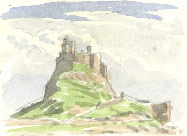 |
Lindisfarne CastleSunday, 8th September 2002, Northumberland |
![]()
![]()
![]()
![]() Rocks |
History |
Workshop |
Links |
Home Page
Rocks |
History |
Workshop |
Links |
Home Page
![]()
 Henry VIII dissolved the monasteries and, towards the end of his reign, ordered that Lindisfarne Castle should be built, using some of the stone from the island's Priory. The priory was used for a time as a military store.
Henry VIII dissolved the monasteries and, towards the end of his reign, ordered that Lindisfarne Castle should be built, using some of the stone from the island's Priory. The priory was used for a time as a military store.With the Union of England and Scotland 1603 the castle fell into disuse. It was restored by Sir Edwin Lutyens in 1903. Gertrude Jekyll laid out the walled garden to the north of the castle.
The Great Whin Sill
Most of the island is underlain by Carboniferous limestone but the castle stands on an outcrop of a hard, medium-grained igneous rock, dolerite, which is part of an igneous intrusion, the Whin Sill. The Great Whin Sill is on average 100 feet thick and extends occurs over an area of 3,900 square kilometres across north east England. Once thought to be a lava flow of Carboniferous age it proved to be an intrusion, squeezed as a molten mass between existing layers of Carboniferous rocks. A fresh unweathered specimen is usually dark blue-grey.St Cuthbert's Island

 Little remains of the monastery founded by St Aidan in 634. The present ruins are those of a Benedictine Priory (1093-1537) built on or near the site of the monastery which was abandoned after attacks by the Vikings.
Little remains of the monastery founded by St Aidan in 634. The present ruins are those of a Benedictine Priory (1093-1537) built on or near the site of the monastery which was abandoned after attacks by the Vikings.St Cuthbert (c. 635-87), who was bishop of Lindisfarne from 685 to 687, is said to have lived for periods as a hermit on the little island (above), which accessible at low tide from the beach at the west end of the village. It is recorded that he befriended the otters and eider ducks.
 Polypody fern (left) grows from the drystone walls of the lane winding down to the rocky beach opposite the island. There are orange sporangia, like miniature pom-poms, dotted on the backs of some of its fronds. Maidenhair spleenwort and
Polypody fern (left) grows from the drystone walls of the lane winding down to the rocky beach opposite the island. There are orange sporangia, like miniature pom-poms, dotted on the backs of some of its fronds. Maidenhair spleenwort and  black spleenwort (right) also grown from the crevices. If I've identified them correctly that is; I'm not brilliant at ferns. However the comblike fronds of polypody are unmistakable.
black spleenwort (right) also grown from the crevices. If I've identified them correctly that is; I'm not brilliant at ferns. However the comblike fronds of polypody are unmistakable.
![]()
Richard Bell,
wildlife illustrator
E-mail; 'richard@willowisland.co.uk'
![]() Next page |
Previous page |
This day last year |
This month |
Nature Diary |
Home Page
Next page |
Previous page |
This day last year |
This month |
Nature Diary |
Home Page
![]()